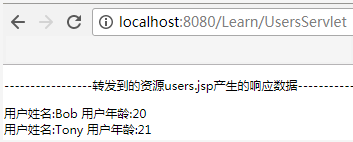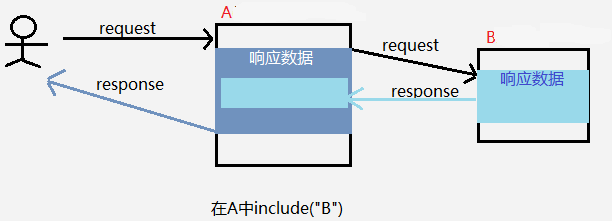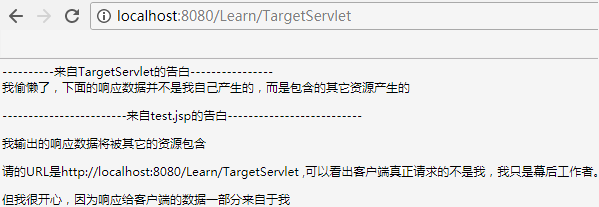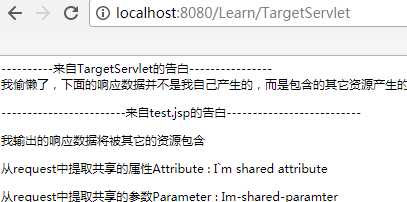您好,登錄后才能下訂單哦!
您好,登錄后才能下訂單哦!
這篇文章給大家介紹Servlet中RequestDispatcher的原理是什么,內容非常詳細,感興趣的小伙伴們可以參考借鑒,希望對大家能有所幫助。
RequestDispatcher簡介
RequestDispatcher 代表請求的派發者。它有2個動作:forward 和 include 。客戶端對于任何一個請求,可以根據業務邏輯需要,選擇不同的處理辦法:
1、請求的是誰,誰就自己處理并響應,例如請求的是一個html,則web瀏覽器顯示的就是這個HTML的內容。
2、使用RequestDispatcher讓其它的資源參與進來,協同完成的響應,這就是RequestDispatcher的主要作用。
RequestDispatcher 有一個特點,就是瀏覽器上顯示的URL是最先請求的目標資源的URL,不會因為使用了forward、include方法而改變。因此forward和include的調用對于用戶來說是透明的。
RequestDispatcher 實質是一個接口,有2個方法分別代表這2個動作。下面一 一介紹。
public interface RequestDispatcher
{
public void forward(ServletRequest request, ServletResponse response)
throws ServletException, IOException;
public void include(ServletRequest request, ServletResponse response)
throws ServletException, IOException;
}RequestDispatcher.forward(request, response)
這個方法將請求從一個 Servlet or JSP目標資源 上 轉發到服務器上的另一個資源(servlet、JSP 文件或 HTML 文件,這些資源必須是當前Web上下文中的),讓其它的資源去生成響應數據。
例如用戶請求的是目標資源A,A接受到請求后,轉發到B,真正產生響應數據是被轉發的資源B,而A只是起個引導轉發作用。瀏覽器的地址欄不會變,依然是A的URL。
這個方法可以允許被請求的目標資源做一些準備工作后,再讓轉發的資源去響應請求。例如下面的例子1。
注意事項:
1、在目標資源中調用forward方法時,必須保證此響應沒有提交。也就是不要使用 ServletResponse 對象的輸出流對象,因為即便你寫入了數據到響應緩沖區,最后也會被清空,如果緩沖區數據被刷新提交(out.flush),還會拋出IllegalStateException異常。
2、對于forward方法傳遞的request對象:雖然我們從調用上看,好像是將request對象傳遞給轉動的資源上去了,但是我發現目標資源使用的request對象和轉發的資源使用的request對象不是同一個request對象,因為分別從這2個request中獲取RequestURL,發現是不一樣的。但是在目標資源request提取的Paramter 和 Attribute ,在轉發后的資源的request對象中,依然都可以提取到,且是相同的。所以,二者只是在請求路徑相關的屬性上不同,其它API調用返回的都是一樣的。
3、在forward語句的前后,都不應該有響應輸出的語句,應該會被忽略。
例子1:一個簡單的 MVC演示。Servlet充當控制器,轉發到view層的jsp。
User.java
public class User{
private String name;
private int age;
public String getName(){
return name ;
}
public void setName( String name ){
this .name = name ;
}
public int getAge() {
return age ;
}
public void setAge( int age ){
this .age = age ;
}
}UsersServlet.java
public class UsersServlet extends HttpServlet {
private static final long serialVersionUID = 1L ;
protected void doGet (HttpServletRequest request, HttpServletResponse response) throws ServletException , IOException {
/*****************一般實際開發這些用戶數據都是從數據庫查出來的*********/
List <User > users = new ArrayList <> ();
User u1 = new User () ;
u1 .setAge ( 20) ;
u1 .setName ( "Bob") ;
User u2 = new User () ;
u2 .setAge ( 21) ;
u2 .setName ( "Tony") ;
users .add ( u1) ;
users .add ( u2) ;
/*********************************************/
request .setAttribute ( "users", users) ; //對request 進制預處理準備工作
request .getRequestDispatcher ( "users.jsp").forward( request , response );//轉發到users.jsp,讓他去具體響應
}
}users.jsp
<%@ page contentType= "text/html; charset=UTF-8" pageEncoding ="UTF-8" trimDirectiveWhitespaces= "true"
session ="true" %>
<%@ taglib prefix= "c" uri = "http://java.sun.com/jsp/jstl/core" %>
<!DOCTYPE html>
< html>
<head>
<meta http-equiv = "Content-Type" content ="text/html; charset=UTF-8">
<title> 用戶列表</title>
</head>
<body>
<p> -----------------轉發到的資源users.jsp產生的響應數據------------------ </p>
< c:forEach var ="user" items= " ${users}" >
用戶姓名:${user.name} 用戶年齡:${user.age} <br />
</ c:forEach>
</body>
</html>
例子2:不使用Attribute,使用Paramter向轉發的資源傳遞參數。
雖然request對象沒有setParameter方法來設置參數,但是我們可以在轉發的URL后通過QueryString 的方式添加。JSP中的<jsp:foward>標簽下的<jsp:param>標簽就是使用的這個原理。

AimServlet.java
public class AimServlet extends HttpServlet {
private static final long serialVersionUID = 1L ;
protected void doGet( HttpServletRequest request , HttpServletResponse response) throws ServletException , IOException {
request .getRequestDispatcher ( "foo.jsp?num=1") . forward( request , response );
}
}foo.jsp
<%@ page contentType= "text/html; charset=UTF-8" pageEncoding ="UTF-8" trimDirectiveWhitespaces= "true"
session ="true" %>
<%@ taglib prefix= "c" uri = "http://java.sun.com/jsp/jstl/core" %>
<! DOCTYPE html>
<html>
<head>
<meta http-equiv = "Content-Type" content ="text/html; charset=UTF-8">
<title> 標題</title>
</head>
<body>
通過forward傳遞過來的參num=${param.num}
</body>
</html>RequestDispatcher.include(request, response)
此方法用于包含響應中某個資源(servlet、JSP 頁面和 HTML 文件)的內容。
調用者指定一個被包含的資源,將這個包含的資源(JSP,Servlet,HTML)的響應數據包含到自己的響應體中。被包含的數據是在服務器上經過運行產生的,因此是動態包含,而不同于JSP中的include指令,它是JSP轉譯期的靜態包含,類似于C語言中的宏一樣。
這個過程實質是用一個相同的Request再請求一次被包含的資源,將被包含的資源的響應數據包含到原本的資源中去,構成它的響應數據的一部分。

注意事項:
1、被包含者不能設置ServletResponse的響應狀態和響應頭(否則并不會產生效果),因為這些都是包含者做的事,被包含者只需要產生響應數據解可以了。
2、不同于 forward中的request的傳遞特性:在被包含的資源中從request中獲取請求路徑相關的信息,發現依然是原始請求的路徑,也就是瀏覽器地址欄相關的路徑,也就是說被包含的資源獲得的request對象的路徑屬性和原始請求資源的路徑一樣(見下面的例子1)。其它的API調用也是一樣的(Attribute 和Parameter)。
例子1
TargetServlet.java
public class TargetServlet extends HttpServlet {
private static final long serialVersionUID = 1L ;
protected void doGet( HttpServletRequest request , HttpServletResponse response) throws ServletException , IOException {
response .setContentType ( "text/html;charset=utf-8" );
PrintWriter out = response .getWriter () ;
out .println ( "----------來自TargetServlet的告白----------------<br />" ) ;
out .print ( "我偷懶了,下面的響應數據并不是我自己產生的,而是包含的其它資源產生的<br/>" ) ;
request .getRequestDispatcher ( "test.jsp") . include( request , response );
out .flush () ;
out .close () ;
}
}test.jsp
<%@ page contentType= "text/html; charset=UTF-8" pageEncoding = "UTF-8" trimDirectiveWhitespaces = "true" session = "false" %> <p> ------------------------來自test.jsp的告白-------------------------- </p> <p> 我輸出的響應數據將被其它的資源包含 </p> 請的URL是 <%= request.getRequestURL().toString() %> ,可以看出客戶端真正請求的不是我,我只是幕后工作者。 <p> 但我很開心,因為響應給客戶端的數據一部分來自于我 </p>

例子2:通過包含路徑后追加QueryString來向被包含資源傳遞參數,以及通過request.setAttribute傳遞屬性。
同樣, JSP中的<jsp:include>標簽下的<jsp:param>標簽就是通過在含路徑后追加QueryString達到的傳遞參數的效果。

public class TargetServlet extends HttpServlet {
private static final long serialVersionUID = 1L ;
protected void doGet( HttpServletRequest request , HttpServletResponse response) throws ServletException , IOException {
response .setContentType ( "text/html;charset=utf-8" );
PrintWriter out = response .getWriter () ;
out .println ( "----------來自TargetServlet的告白----------------<br />" ) ;
out .print ( "我偷懶了,下面的響應數據并不是我自己產生的,而是包含的其它資源產生的<br/>" ) ;
request .setAttribute ( "sharedatt", "I`m shared attribute") ;
request .getRequestDispatcher ( "test.jsp?sharedparam=Im-shared-parameter" ). include (request , response ) ;
out .flush () ;
out .close () ;
}
}<%@ page contentType= "text/html; charset=UTF-8" pageEncoding = "UTF-8" trimDirectiveWhitespaces = "true"
session = "false"
%>
<p> ------------------------來自test.jsp的告白-------------------------- </p>
<p> 我輸出的響應數據將被其它的資源包含 </p>
<p> 從request中提取共享的屬性Attribute : <%= request.getAttribute("s haredatt") %>
<p> 從request中提取共享的參數Parameter : <%= request.getParameter("sharedparam" ) %>
關于Servlet中RequestDispatcher的原理是什么就分享到這里了,希望以上內容可以對大家有一定的幫助,可以學到更多知識。如果覺得文章不錯,可以把它分享出去讓更多的人看到。
免責聲明:本站發布的內容(圖片、視頻和文字)以原創、轉載和分享為主,文章觀點不代表本網站立場,如果涉及侵權請聯系站長郵箱:is@yisu.com進行舉報,并提供相關證據,一經查實,將立刻刪除涉嫌侵權內容。